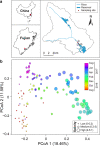Low shifts in salinity determined assembly processes and network stability of microeukaryotic plankton communities in a subtropical urban reservoir
- PMID: 34082826
- PMCID: PMC8176698
- DOI: 10.1186/s40168-021-01079-w
Low shifts in salinity determined assembly processes and network stability of microeukaryotic plankton communities in a subtropical urban reservoir
Abstract
Background: Freshwater salinization may result in significant changes of microbial community composition and diversity, with implications for ecosystem processes and function. Earlier research has revealed the importance of large shifts in salinity on microbial physiology and ecology, whereas studies on the effects of smaller or narrower shifts in salinity on the microeukaryotic community in inland waters are scarce. Our aim was to unveil community assembly mechanisms and the stability of microeukaryotic plankton networks at low shifts in salinity.
Results: Here, we analyzed a high-resolution time series of plankton data from an urban reservoir in subtropical China over 13 consecutive months following one periodic salinity change ranging from 0 to 6.1‰. We found that (1) salinity increase altered the community composition and led to a significant decrease of plankton diversity, (2) salinity change influenced microeukaryotic plankton community assembly primarily by regulating the deterministic-stochastic balance, with deterministic processes becoming more important with increased salinity, and (3) core plankton subnetwork robustness was higher at low-salinity levels, while the satellite subnetworks had greater robustness at the medium-/high-salinity levels. Our results suggest that the influence of salinity, rather than successional time, is an important driving force for shaping microeukaryotic plankton community dynamics.
Conclusions: Our findings demonstrate that at low salinities, even small increases in salinity are sufficient to exert a selective pressure to reduce the microeukaryotic plankton diversity and alter community assembly mechanism and network stability. Our results provide new insights into plankton ecology of inland urban waters and the impacts of salinity change in the assembly of microbiotas and network architecture. Video abstract.
Keywords: Community ecology; Core taxa; Deterministic processes; Microeukaryotic plankton; Network stability; Salinity; Satellite taxa; Stochastic processes; Subtropical reservoir.
Conflict of interest statement
The authors declare that they have no competing interests.
Figures






Similar articles
-
Climate Change Causes Salinity To Become Determinant in Shaping the Microeukaryotic Spatial Distribution among the Lakes of the Inner Mongolia-Xinjiang Plateau.Microbiol Spectr. 2023 Aug 17;11(4):e0317822. doi: 10.1128/spectrum.03178-22. Epub 2023 Jun 12. Microbiol Spectr. 2023. PMID: 37306569 Free PMC article.
-
Stochastic processes shape microeukaryotic community assembly in a subtropical river across wet and dry seasons.Microbiome. 2019 Oct 22;7(1):138. doi: 10.1186/s40168-019-0749-8. Microbiome. 2019. PMID: 31640783 Free PMC article.
-
Environmental DNA metabarcoding reveals the influence of environmental heterogeneity on microeukaryotic plankton in the offshore waters of East China Sea.Environ Res. 2024 Dec 1;262(Pt 2):119921. doi: 10.1016/j.envres.2024.119921. Epub 2024 Sep 2. Environ Res. 2024. PMID: 39233035
-
Long-term oceanographic and ecological research in the Western English Channel.Adv Mar Biol. 2005;47:1-105. doi: 10.1016/S0065-2881(04)47001-1. Adv Mar Biol. 2005. PMID: 15596166 Review.
-
Human-induced salinity changes impact marine organisms and ecosystems.Glob Chang Biol. 2023 Sep;29(17):4731-4749. doi: 10.1111/gcb.16859. Epub 2023 Jul 12. Glob Chang Biol. 2023. PMID: 37435759 Review.
Cited by
-
Microbial community assembly patterns at the species level in different parts of the medium temperature Daqu during fermentation.Curr Res Food Sci. 2024 Oct 11;9:100883. doi: 10.1016/j.crfs.2024.100883. eCollection 2024. Curr Res Food Sci. 2024. PMID: 39493699 Free PMC article.
-
Assembly and Network Stability of Planktonic Microorganisms under the Influence of Salinity Gradient: an Arctic Case Study from the Lena River Estuary to the Laptev Sea.Microbiol Spectr. 2023 Feb 6;11(2):e0211522. doi: 10.1128/spectrum.02115-22. Online ahead of print. Microbiol Spectr. 2023. PMID: 36744927 Free PMC article.
-
Climate Change Causes Salinity To Become Determinant in Shaping the Microeukaryotic Spatial Distribution among the Lakes of the Inner Mongolia-Xinjiang Plateau.Microbiol Spectr. 2023 Aug 17;11(4):e0317822. doi: 10.1128/spectrum.03178-22. Epub 2023 Jun 12. Microbiol Spectr. 2023. PMID: 37306569 Free PMC article.
-
Survey of gut microbial biogeography and their functional niche in the grow-finishing swine of ordinary feeding.Front Microbiol. 2025 Mar 7;16:1530553. doi: 10.3389/fmicb.2025.1530553. eCollection 2025. Front Microbiol. 2025. PMID: 40124893 Free PMC article.
-
Controlling metabolic stability of food microbiome for stable indigenous liquor fermentation.NPJ Biofilms Microbiomes. 2025 Jul 1;11(1):124. doi: 10.1038/s41522-025-00729-3. NPJ Biofilms Microbiomes. 2025. PMID: 40593731 Free PMC article.
References
-
- Brucet S, Boix D, Quintana XD, Jensen E, Nathansen LW, Trochine C, Meerhoff M, Gascón S, Jeppesena E. Factors influencing zooplankton size structure at contrasting temperatures in coastal shallow lakes: implications for effects of climate change. Limnol Oceanogr. 2010;55(4):1697–1711. doi: 10.4319/lo.2010.55.4.1697. - DOI
-
- Dugan HA, Bartlett SL, Burke SM, Doubek JP, Krivak-Tetley FE, Skaff NK, Summers JC, Farrell KJ, McCullough IM, Morales-Williams AM, Roberts DC, Ouyang Z, Scordo F, Hanson PC, Weathers KC. Salting our freshwater lakes. Proc Natl Acad Sci U S A. 2017;114(17):4453–4458. doi: 10.1073/pnas.1620211114. - DOI - PMC - PubMed
-
- Jeppesen E, Beklioğlu M, Özkan K, Akyürek Z. Salinization increase due to climate change will have substantial negative effects on inland waters and freshwater resources: a call for multifaceted research at the local and global scale. Innovation. 2020;1(2):100030. doi: 10.1016/j.xinn.2020.100030. - DOI - PMC - PubMed
-
- Slangen ABA, Church JA, Agosta C, Fettweis X, Marzeion B, Richter K. Anthropogenic forcing dominates global mean sea-level rise since 1970. Nat Clim Chang. 2016;6(7):701–705. doi: 10.1038/nclimate2991. - DOI
Publication types
MeSH terms
LinkOut - more resources
Full Text Sources

